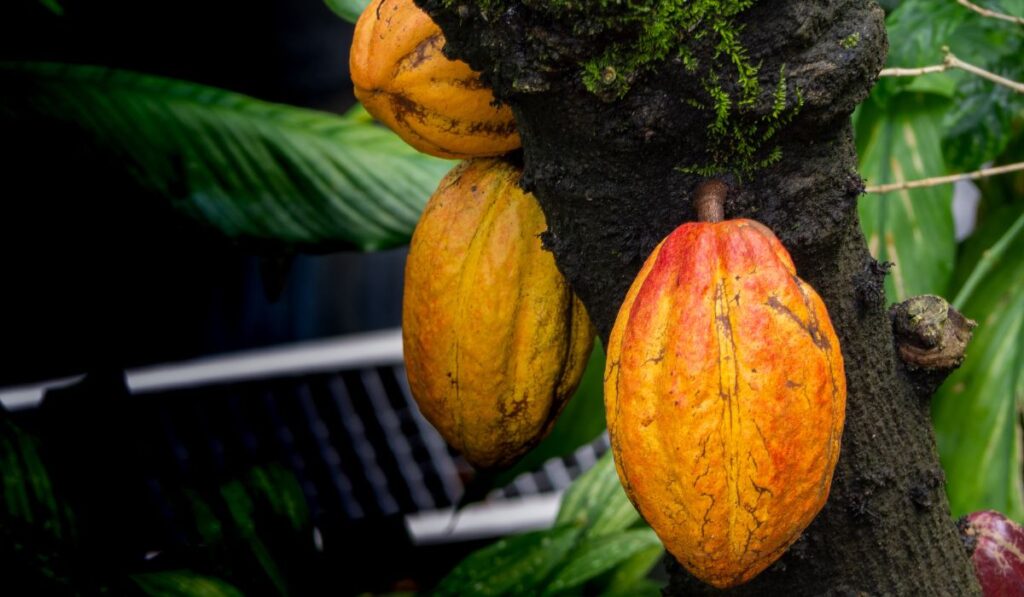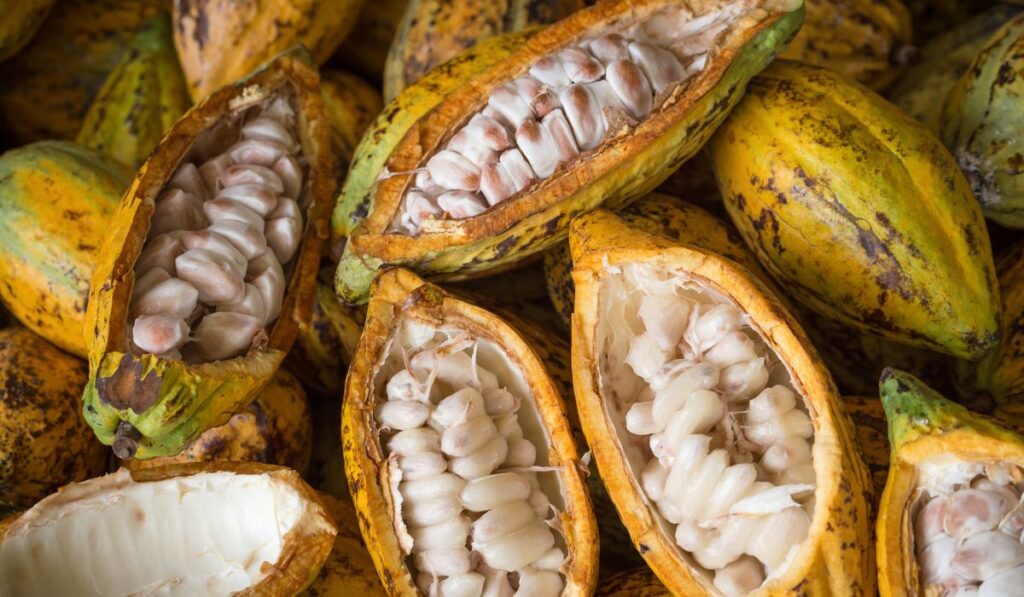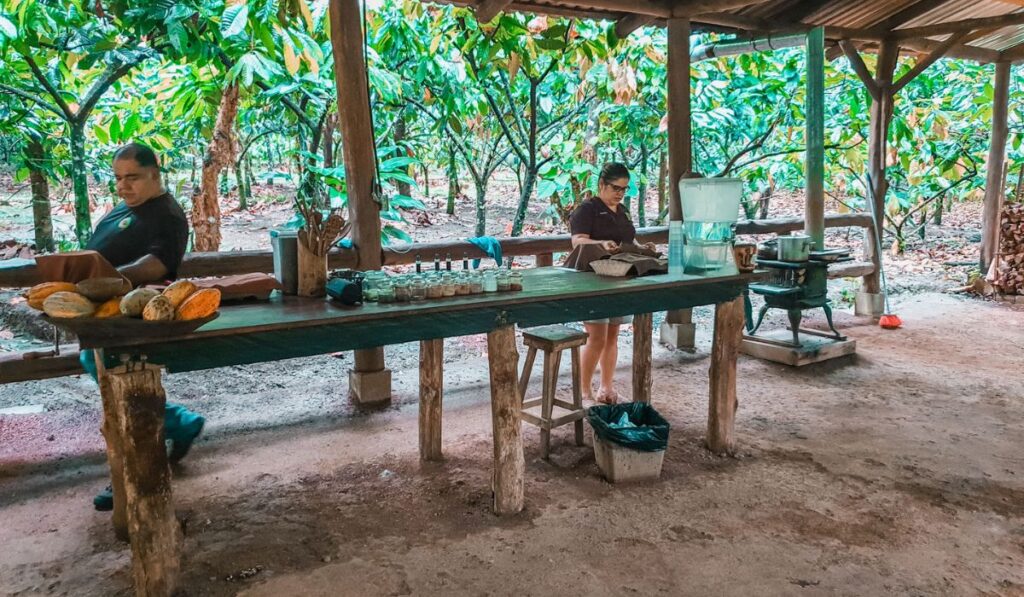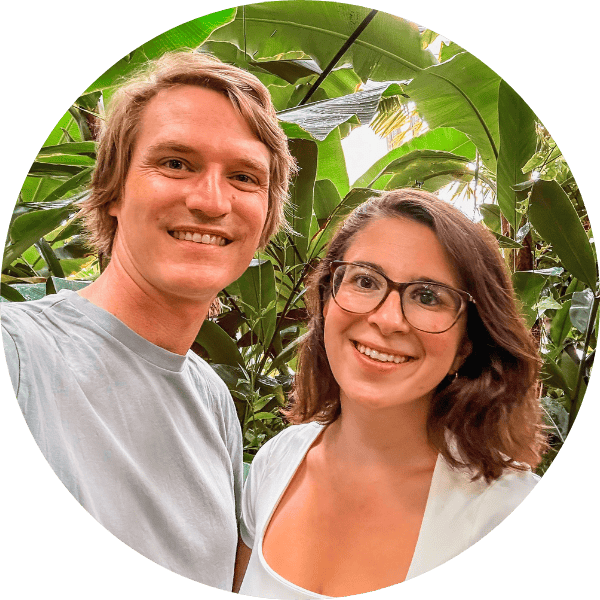Disclaimer: This article may contain affiliate links. Clicking on them may earn Costa Rica Vibes a commission, at no extra cost to you. Thank you for your support!
Costa Rica Chocolate Tours – A Fun Activity for All Ages
Have you ever eaten fresh chocolate which was created from cacao beans right in front of you? On a Costa Rica chocolate tour you can experience this first hand. It’s the perfect activity for all ages.
We tend to think of chocolate as a sweet and unhealthy treat, but cacao in its most natural form has several health benefits including aiding in weight loss and improving brain health.
In Costa Rica you can learn all about the cacao growth process, the production of cacao, the overproduced chocolate most people buy in the grocery store versus pure chocolate, and much more!
History of Chocolate in Costa Rica

The Latin term for cacao “Theobroma Cacao” literally translates to “food of the Gods.” This is very fitting because to the Costa Rican indigenous people, it was a food of the Gods and considered a sacred plant.
Cacao was often turned into a luscious drink that was used in special rituals.
In fact, until the 1930’s it was used as a form of currency by the Costa Rican Chorotega tribe.
In the past, Cacao was Costa Rica’s leading export surpassing even coffee beans. Unfortunately, in the 1970’s a fungus wiped out about 80% of the cacao grown in the country.
Eventually, cacao plants that are immune to fungus were introduced and cacao growth became a viable industry once again.
Costa Rica is not a huge producer of chocolate nowadays because it is much cheaper to produce chocolate in other countries.
However, the environment is great for growing cacao plants and you can occasionally find single-origin chocolate from Costa Rica even in your own local supermarket.
The Cacao Growing and Production Process

Cacao beans grow on a cacao tree in pods. The pods start out green but turn red when they are ready to be harvested. They will then be cut down from the tree usually by machete.
Once the cacao pods are harvested, they are cut open and all cacao beans are removed from inside.
As you can see, the beans are covered in this white fluffy outer layer. This is edible, and in my experience, it doesn’t taste bad, but not exactly delicious either.
The beans then go through a fermentation process. In Costa Rica, this typically means leaving the beans to warm in the sun or this can be done by covering the beans with large banana leaves. This step typically lasts five to eight days.
The next step is to actually dry out the cacao. This process involves laying the beans on metal grates in the sun or below a heat lamp. This step typically lasts for a week.
From there, the cacao beans can be processed and turned into chocolate.
The cacao bean is then roasted and the outer shell is removed. You are then left with what is called a cacao nib.
Have you ever eaten cacao nibs? They are very healthy but have a bitter taste. Plus, they tend to get majorly stuck in your teeth.
Cacao nibs are then ground down into a creamy substance. This is achieved by heating the cacao nibs as they are being ground. The high fat content in the nibs melts down to make a creamy outcome.
From there, sugar, milk, and other flavorings may be added before the chocolate hardens into its final form.
It’s an interesting process to experience in person. Which, you will have the chance to see while on a chocolate tour in Costa Rica.
The Best Costa Rica Chocolate Tours

The nice thing about chocolate tours in Costa Rica is that there are plantations located all over the country. No matter which area you plan to visit you can most likely find a tour nearby. Here are some of our favorites.
Rainforest Chocolate Tour – La Fortuna
Rainforest Chocolate Tour is located in La Fortuna, just down the street from the La Fortuna waterfall.
This chocolate tour is always excellent!
They don’t have a huge plantation, but you can see some cacao trees at various stages of growth. You will also see beans in the different stages of drying.
Most of the tour involves sitting and watching as cacao is turned into chocolate.
The tour guides here are great! They make the whole process completely interactive and get everybody in the group involved and excited.
The tour always ends with everyone being able to eat as much chocolate as they want. Yum!
One of the great things about this tour is that because it involves very little walking, people of all ages can participate and will enjoy this.
If you would like to pre-book your tour you can do that here.
Sibu Chocolate Tour – Heredia
Sibu is a chocolate company which produces their own chocolate bars. They have three shop locations around the San Jose area. One of their locations, in Heredia, offers tasting tours. Keep in mind that this is not a plantation tour, strictly tasting.
Their tours last for one hour and will teach you all about the different grades of dark chocolate as well as how to evaluate the taste.
Sibu also has a nice cafe on-site if you would like to combine your tasting with a delicious lunch.
Choco – Puerto Viejo
Choco, which is located in Puerto Viejo offers a completely unique, more adult experience. Here you can book a variety of chocolate tastings such as a chocolate and beer, wine, or rum pairing.
They also offer guided cacao plantation tours, chocolate making workshops, and more.
Choco also has a nice boutique shop filled with delicious gourmet chocolate products.
This would be a great date spot or a fun activity for a group of adults.
Chocolate Tours – Manuel Antonio
The Manuel Antonio Chocolate Tours company combines four amazing things in one tour; coffee, chocolate, sugar production, and medicinal plants.
Their tours include transportation from your hotel in the Manuel Antonio area, a tour guide, and the opportunity to eat many delicious treats.
You can find more about booking your tour here.
Caribbeans Chocolate – Puerto Viejo
The Caribbeans Chocolate in Puerto Viejo is an immersive experience that involves a hike through their plantation, tasting the cacao fruit, as well as a tour of their chocolate-making process.
This tour requires participants to be somewhat physically fit in order to participate in the one-mile hike.
The tours here are conducted on a walk-up basis. No reservations are necessary. However, if you would like to book a private tour or get more info you can contact them via the Caribbeans Chocolate website.
After your tour, you can buy some of their bean to bar chocolate bars in the company gift shop.
Our Chocolate Tour Tips
- The chocolate tour companies I listed above are very popular. Typically, you don’t need to book months in advance, but it is not a bad idea to contact them a week or two before you would like to visit to book a spot.
- Most cacao forests can get a bit buggy. We suggest packing bug spray and wearing close-toed shoes on your tour.
- Typically we suggest arranging your chocolate tour directly with each chocolate company and driving to the chocolate farm location yourself. This is usually the cheapest for you. However, if you are not planning to rent a car, it might be best to book a tour which includes transportation.
- Costa Rican chocolate is always a good souvenir idea. I mean, who wouldn’t appreciate some chocolate? You can buy chocolate bars made from Costa Rican cacao at all tour companies listed above. It is also possible to purchase authentic chocolate at most larger grocery stores in Costa Rica.
What do you think? Are you ready to learn all about how delicious chocolate is produced while on a tour? Let us know if you have any questions in the comment section below. We are happy to help!
You Might Also Like:
Costa Rica Travel Details: What You Need to Know
🚗 Should I rent a car in Costa Rica?
Having a rental car will give you the most flexibility when traveling in Costa Rica. This will also allow you to take fun day trips on your own.
- Save 10% Plus Other Perks with Our Adobe Rental Car Discount
- You might also consider; shared shuttle services or private transfer services
🏄🏽 How can I book things to do?
We find that Viator tends to have the most comprehensive selection of activities with secure booking and good cancellation policies.
🍍 I’m overwhelmed with planning. Can you help?
Of course! I suggest joining our Facebook group for specific questions and head to our Start Here Page to get started planning.
✈️ What is the best way to book a flight?
Usually, we have the best luck finding great prices with Skyscanner. Check for flights to both San Jose Airport (SJO) and Liberia Airport (LIR).
🛏️ What is the best way to book my Costa Rica hotels?
We highly suggest Booking.com for hotel bookings and typically use VRBO for Costa Rica vacation rentals.
🗣️What is the main language in Costa Rica?
The main language in Costa Rica is Spanish. Most people working in tourism speak at least some English.
💰 What is the currency in Costa Rica?
The currency used in Costa Rica is the Costa Rican colón (CRC). However, the US dollar is widely accepted in most tourist areas
📞 What is the best way to stay connected?
An eSIM from Airalo is the easiest way to get 4G data while traveling in Costa Rica.
🌴 Is Costa Rica safe?
Generally, Costa Rica is considered safe for tourists. However, like any travel destination, it’s best to use caution and be aware of your surroundings.
🛂 Do you need a passport to go to Costa Rica?
Yes, Costa Rica is its own country. You will need a passport to visit.

Hi! We’re Thomas (the German) and Sarah (the US-er)
We met in Virginia, moved to Germany, and since 2016 we have lived in sunny Costa Rica.
It was a spontaneous decision to move here, but it was the best decision!
Now we spend our days roaming the country to bring you the very best in Costa Rica travel here on Costa Rica Vibes.
Sarah is the writer. Thomas is the one keeping it all together.
Want the whole crazy story?

Sarah McArthur
Sarah McArthur is the co-founder and main writer of Costa Rica Vibes.
She is originally from the United States but has lived in sunny San Jose, Costa Rica since 2016.
She has traveled all over the country and now considers herself a self-proclaimed Costa Rica travel expert.
Want the whole crazy story?

